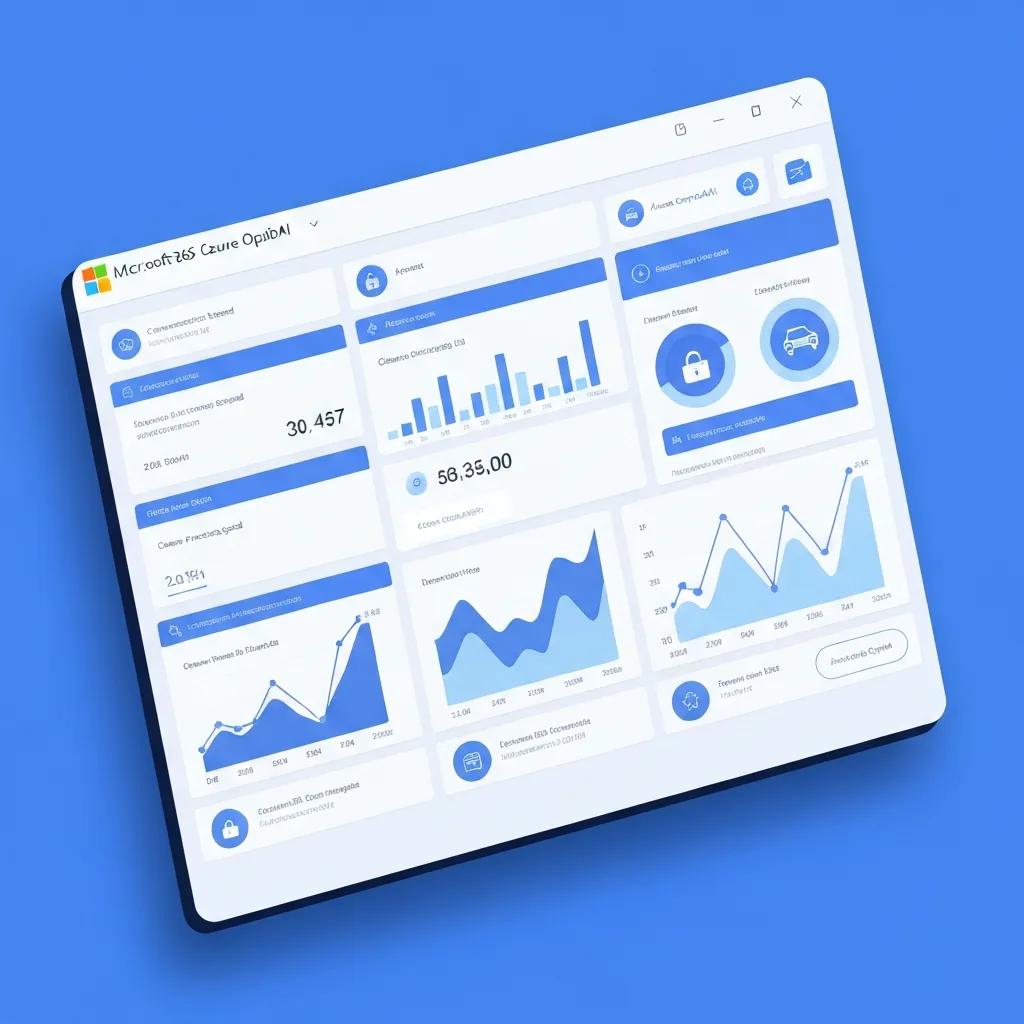How Microsoft 365 Copilot and Azure OpenAI Are Transforming Insurance Operations—from Underwriting to Fraud Detection
Insurance leaders are rapidly adopting cloud AI to reduce manual work, accelerate decisions, and detect fraud earlier; this article explains how Microsoft 365 Copilot and the Azure OpenAI Service deliver those outcomes across underwriting, claims, fraud, and customer service. You will learn what each solution does, how they differ and complement one another, and practical steps insurers can take to integrate them with existing data and workflows. The piece contrasts Copilot’s productivity and knowledge-in-context strengths with Azure OpenAI’s large-language-model capabilities for unstructured data, then maps role-based impacts for underwriters, claims adjusters, agents, and fraud investigators. Finally, we cover compliance and measurement—KPIs insurers should track—and a short, action-oriented prompt for teams evaluating these Microsoft-driven options. Throughout, the article references related Microsoft technologies such as Azure AI Document Intelligence, Azure AI Vision, Microsoft Cloud for Financial Services, and GPT-series models to show a coherent platform approach for AI-powered insurance operations.
How Does Microsoft 365 Copilot Revolutionize Insurance Underwriting and Productivity?
Microsoft 365 Copilot is an in-app generative AI assistant that works inside Word, Excel, Outlook, and Teams to summarize documents, automate routine drafting, and surface contextual insights that speed underwriting decisions. It leverages document summarization and data analysis to reduce time spent combing through applications and loss runs, producing concise risk synopses and suggested next steps that improve throughput. The direct benefit is faster quote turnaround and reduced manual synthesis, enabling underwriters to focus on judgment rather than paperwork. The next section shows specific task-level mappings and expected outcomes for underwriting teams.
Copilot capability mapping for common underwriting tasks:
- Copilot accelerates data synthesis from applications and loss runs, producing risk summaries that reduce review time.
- Copilot aids model interpretation by transforming spreadsheet outputs into plain-language recommendations.
- Copilot streamlines communication by drafting proposal text and client emails in context.
This list highlights typical productivity gains and sets up a task-by-task comparison in the table below.
The table clarifies how Copilot maps to underwriting workflows and prepares readers for a brief workflow example of Copilot in action.
How Does Copilot Streamline Data Analysis and Risk Assessment in Underwriting?
Copilot streamlines data analysis in underwriting by synthesizing structured and unstructured inputs into prioritized risk findings and suggested next actions, which reduces cognitive load for underwriters. It ingests application forms, prior policies, and loss runs—often via integrations with Azure AI Document Intelligence—and produces short risk summaries and potential coverage issues that a human underwriter then validates. An example workflow: upload loss runs and past-app documents into Teams, ask Copilot to summarize key frequency/severity trends, and receive a one-paragraph risk synopsis plus suggested follow-up questions for the broker. This workflow underscores how Copilot turns raw data into decision-ready insights while preserving human oversight for final judgment.
How Does Copilot Enhance Agent and Broker Efficiency in Insurance Operations?
For agents and brokers, Copilot reduces time spent on routine communications and renewals by generating tailored emails, proposal drafts, and meeting recaps that reflect client context and policy history. Integrated with Outlook and Teams, Copilot can pull recent policy notes and produce an agenda or action-items list after calls, shortening administrative cycles. A common use case involves an agent preparing a renewal: Copilot drafts a comparative summary of expiring terms and a personalized email to the client, leaving the agent to review and send. These productivity gains improve responsiveness and free agents to focus on relationship-building and complex sales rather than document drafting.
What Role Does Azure OpenAI Play in Advanced Fraud Detection and Claims Processing?

Azure OpenAI Service applies large-language models (LLMs) and semantic analytics to unstructured claims text, customer communications, and multi-modal inputs to identify anomalous patterns and extract actionable facts for triage and investigator workflows. Its mechanisms include semantic similarity matching, anomaly scoring across claim histories, and high-quality NLP extraction that populates structured fields for downstream decisioning. The business outcomes are higher fraud detection lift and faster claim triage, enabling earlier intervention and lower payouts on suspicious claims. The next paragraphs illustrate detection techniques and claims acceleration with a compact EAV comparison for manual versus AI-assisted steps.
Before the table, here are key mechanisms Azure OpenAI uses:
- Semantic similarity to surface suspicious claim narratives against known fraud patterns.
- NLP extraction to convert unstructured reports into structured claim attributes.
- Integration capability with rules engines and investigator workflows for explainable alerts.
These mechanisms feed into measurable outcomes summarized in the table below.
How Does Azure OpenAI Detect Fraud and Analyze Claims Data Effectively?
Azure OpenAI detects fraud by combining pattern recognition with semantic matching across claim narratives and supporting documents, flagging outliers for human review rather than making autonomous decisions. The service can compute similarity scores between a new claim and historical fraudulent cases, surface inconsistent statements, and extract entities such as names, dates, and injury descriptions to feed fraud-scoring models. In practice, insurers use these outputs to boost investigator productivity and improve the signal-to-noise ratio of alerts, which leads to more efficient allocation of investigative resources. This approach preserves human oversight and integrates explainability into investigator workflows to support defensible outcomes.
Research indicates that generative AI can significantly transform claims processing and customer support in P&C insurance.
How Does Azure OpenAI Accelerate Claims Processing and Decision Optimization?
Azure OpenAI accelerates claims processing by automating intake classification, extracting key fields from documents, and generating suggested assessment summaries that claims adjusters validate, reducing manual review steps. A typical flow: claim intake → LLM extraction of damages and policy data → automated triage into low/medium/high workflows → human-in-the-loop review for recommended payouts. Compared to fully manual pipelines, this reduces average handling time and increases throughput while maintaining adjudicator control. The resulting efficiency gains translate into faster payouts for straightforward claims and more focused human attention on complex cases.
How Do Microsoft 365 Copilot and Azure OpenAI Together Transform the End-to-End Insurance Value Chain?

Combined, Microsoft 365 Copilot and Azure OpenAI create a layered AI capability where Copilot amplifies human productivity and knowledge retrieval, while Azure OpenAI delivers deep LLM-driven analysis of unstructured data—together increasing decision velocity and accuracy across underwriting, fraud detection, and customer interactions. Copilot handles context-aware drafting and synthesis inside productivity apps, and Azure OpenAI provides scalable NLP, anomaly detection, and model-assisted triage at the platform level; the two integrate via Microsoft Cloud for Financial Services and services like Azure AI Document Intelligence and Azure AI Vision. Below is a concise mapping of capability to role and outcome to illustrate end-to-end impact.
- Capability → Copilot/Azure OpenAI → Outcome
- Underwriting → Copilot synthesizes documents; Azure OpenAI analyzes unstructured risk narratives → Faster, more accurate risk decisions
- Claims/Fraud → Azure OpenAI automates extraction and scoring; Copilot drafts investigator summaries → Higher detection rates and quicker resolutions
This synthesis demonstrates how the layered approach drives operational KPIs such as time-to-quote, claims cycle time, and fraud detection uplift, and leads naturally into practical next steps for teams evaluating these technologies.
For insurers ready to explore these combined benefits, practical vendor and partner engagement is the next step; options include partnering with implementation specialists and insurtechs that integrate Microsoft technologies while preserving governance and compliance. Vendors and implementation partners known for Microsoft-focused projects include Avanade, O365CloudExperts, Quess GTS, and specialist insurtechs; these partners help operationalize Copilot and Azure OpenAI within secure, monitored environments. If your team needs a checkpoint to begin evaluation, consider compiling a short requirements brief that lists data sources, privacy constraints, key KPIs, and desired partner capabilities to share with potential integrators.
What Are the Combined Benefits for Underwriting, Fraud Detection, and Customer Service?
The primary combined benefits are faster decision cycles, improved detection and accuracy through multimodal analysis, and enhanced customer experience via quicker responses and clearer communications. Copilot reduces time spent on drafting and synthesis, while Azure OpenAI improves signal extraction from unstructured inputs, together lowering operational cost-per-decision and improving first-contact resolution. Below is a role-focused micro-mapping that shows capability, which Microsoft tool plays the main role, and the tangible business outcome.
- Underwriter: Copilot synthesizes documents; Azure OpenAI adds semantic risk signals → Increased throughput and better risk selection.
- Claims adjuster: Azure OpenAI extracts facts and triages; Copilot composes investigator briefings → Faster settlements and focused investigations.
- Customer service: Copilot drafts responses; Azure OpenAI summarizes case history → Improved response time and consistency.
This mapping clarifies how role-specific workflows benefit from both productivity and analytic layers, and it sets up the discussion on governance and responsible AI that follows.
How Do These AI Solutions Support Compliance and Responsible AI Use in Insurance?
Responsible AI in insurance requires data residency controls, human-in-loop review, model monitoring, and audit trails to support regulatory inquiries and maintain consumer trust when using Microsoft 365 Copilot and Azure OpenAI. Practical controls include logging model inputs and outputs for auditability, restricting sensitive data flows through classification policies, and implementing approval gates where humans must sign off on decisions affecting coverage or payouts. Integration with platform governance—such as Microsoft Cloud for Financial Services controls and AKS-based deployment patterns for custom models—helps enforce security and compliance. A short checklist follows to help insurers prepare governance controls before deployment.
Compliance readiness checklist:
- Define data residency and classification requirements for PII and health data.
- Implement human approval gates for high-impact automated decisions.
- Establish monitoring and explainability practices for model outputs.
This checklist provides immediate actions insurers can take to align AI deployments with regulatory expectations and internal risk tolerance.
What Are the Key Considerations and Future Trends for AI Adoption in Insurance Operations?
Insurers planning AI adoption should prioritize data readiness, governance, and practical integration patterns while watching trends like multimodal models, fine-tuning of GPT-series models for domain specificity, and deeper plug-ins between productivity and platform AI services. Data readiness means cleaning policy, claims, and historical fraud datasets and mapping legal constraints; governance covers access controls, monitoring, and explainability; integration focuses on APIs connecting Microsoft 365 Copilot, Azure AI Document Intelligence, and downstream underwriting or claims systems. These considerations shape an implementation roadmap that balances rapid proof-of-value pilots with robust controls. The final sections provide an actionable integration checklist and KPIs to measure success.
What Should Insurers Know About Integrating Microsoft AI Solutions?
Integration requires establishing reliable data pipelines, choosing the right Microsoft platform services for extraction and hosting, and coordinating change management so users trust AI-augmented workflows. Key steps include inventorying source systems, mapping required APIs (for Excel/Word/Teams integration and Azure service calls), and defining user roles and review responsibilities to maintain human oversight. Insurers should also plan for incremental pilots—start with one line of business or process—and leverage partners experienced with Microsoft Cloud for Financial Services or AKS deployments for scalable production. These practical integration steps help avoid overreach while enabling measurable early wins.
How Can Insurers Measure Success and ROI from AI-Powered Insurance Operations?
Measuring ROI requires selecting operational and effectiveness KPIs and tracking them with a defined cadence; examples include time-to-quote, claims cycle time, fraud detection rate, cost-per-claim, and user adoption metrics. Recommended KPIs and cadence:
- Time-to-quote: measure weekly to capture underwriting throughput improvements.
- Claims cycle time: track monthly to assess process acceleration from triage and extraction.
- Fraud detection rate / detection uplift: measure monthly to quantify model impact.
- Cost-per-claim: assess quarterly to understand overall efficiency gains.
- User adoption and satisfaction: track weekly/monthly to ensure human workflows are improving.
By monitoring these KPIs and coupling them with governance metrics (false positives, escalation rates), insurers can validate the value of Microsoft 365 Copilot and Azure OpenAI investments and iterate on pilots to expand successful use cases.


